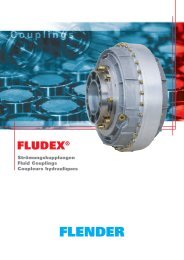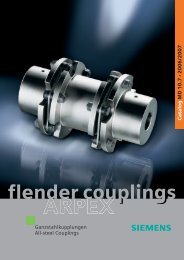flender couplings
flender couplings
flender couplings
Create successful ePaper yourself
Turn your PDF publications into a flip-book with our unique Google optimized e-Paper software.
Zahnkupplungen<br />
�����-��-<br />
Gear Couplings Accouplements à denture<br />
Technische Hinweise für den Design Hints for the Installation Renseignements techniques sur<br />
Einbau le montage<br />
1. Anordnung der Kupplungsteile<br />
Die Anordnung der Kupplungsteile auf den zu<br />
verbindenden Wellenenden ist entsprechend den<br />
Ausführungen A, AB und B vorzusehen.<br />
2. Bohrungen<br />
Die den Fertigbohrungen zugeordneten Toleranzfelder<br />
sind der Tafel 24.I zu entnehmen.<br />
3. Befestigung<br />
ZAPEX-Kupplungen werden normalerweise mit<br />
Paßfedernuten nach DIN 6885 Teil 1 und Stellschrauben<br />
ausgeführt. Ausführungen mit Keilnuten<br />
nach DIN 6886, Anzug von der Nabeninnenseite,<br />
sind möglich.<br />
Für Warmaufsetzen oder Aufpressen mittels<br />
Druckölverfahren sind detaillierte Angaben erforderlich.<br />
Bei allen Kupplungsgrößen sind die Gewindebohrungen<br />
für die Stellschrauben oberhalb der<br />
Paßfedernut angeordnet.<br />
4. Lagerung der Wellenenden<br />
Die zu verbindenden Wellenenden sollen unmittelbar<br />
vor und hinter der Kupplung gelagert<br />
sein.<br />
Um ein Erneuern der Dichtringe ohne ein Verschieben<br />
der Maschinen zu ermöglichen, sind die<br />
Maße P und d6 in den Tafeln 10.I bis 20.I zu berücksichtigen.<br />
5. Auswuchten<br />
Allgemein: In einer Ebene, Gütestufe Q 16 bei<br />
v ≤ 36 m/s, jedoch bei nmax = 1500 min-1 , vor<br />
dem Nuten.<br />
Das Zwischenstück der Bauart ZIZS wird ab<br />
v = 15 m/s in zwei Ebenen, Gütestufe Q 6,3 ausgewuchtet.<br />
Ausgewuchtet wird nach dem Halbkeilprinzip<br />
(DIN/ISO 8821)<br />
Nach Vereinbarung: Ist für das Betriebs- bzw.<br />
Anlagenverhalten eine feinere Wuchtgüte<br />
erforderlich, so ist dieses gesondert zu vereinbaren.<br />
Flender empfiehlt bei Umfangsgeschwindigkeiten<br />
v > 36 m/s eine Wuchtgüte<br />
Q 6,3 (oder feiner) in zwei Ebenen, jedoch bei<br />
n max = 1500 min-1 , mit Fertigbohrung, vor dem<br />
Nuten (oder nach Angaben des Bestellers).<br />
Soll die Auswuchtung nach dem Vollkeil-<br />
Prinzip erfolgen, ist der ausdrückliche Hinweis<br />
erforderlich.<br />
6. Sicherheits-Vorkehrungen<br />
Umlaufende Teile müssen vom Käufer gegen<br />
unbeabsichtigtes Berühren gesichert werden<br />
(Gesetz über technische Arbeitsmittel vom 23.<br />
Oktober 1992)<br />
Bei Lieferungen ins Ausland sind die dort gültigen<br />
Sicherheitsbestimmungen zu beachten.<br />
Achtung!<br />
Unbedingt die Anweisungen der zugehörigen<br />
Betriebsanleitung beachten.<br />
Siemens MD 10.13 � 2006/2007<br />
1. Arrangement of the coupling parts<br />
The arrangement of hubs and flanged sleeves on<br />
the shaft ends to be connected must correspond<br />
to assembly A, AB or B.<br />
2. Bores<br />
See table 24.I for tolerance zones of finished<br />
bores.<br />
3. Securing the coupling<br />
ZAPEX <strong>couplings</strong> are usually provided with<br />
parallel keyways acc. to DIN 6885/1 and set<br />
screws. Designs with taper keyways acc. to DIN<br />
6886, stressed-type fastening from the inside of<br />
the hub, are possible.<br />
Full details should be supplied if <strong>couplings</strong> are to<br />
be shrunk on or mounted by hydraulic means.<br />
In all coupling sizes, the tapped holes for the set<br />
screws are located above the keyways.<br />
4. Supporting the shaft ends<br />
The shaft ends to be connected should be supported<br />
in bearings directly in front of and behind<br />
the coupling.<br />
To permit replacement of the sealing rings without<br />
moving the machines, the dimensions P and d6 in tables 10.I to 20.I must be taken into consideration.<br />
5. Balancing<br />
General: In one plane, quality Q 16 at v ≤ 36 m/s,<br />
but at n max = 1500 min -1 before keyseating.<br />
From v = 15 m/s up, the spacer of type ZIZS is<br />
balanced in two planes, quality Q 6.3.<br />
Balancing is carried out with half parallel key<br />
(DIN/ISO 8821)<br />
To be agreed: If operating or plant behaviour<br />
requires a higher balancing quality, this must be<br />
agreed separately. For peripheral speeds of v ><br />
36 m/s, Flender recommends a balancing<br />
quality of Q 6.3 (or finer) in two planes, but at nmax = 1500 min-1 , with finished bore, before keyseating<br />
(or to order specification).<br />
If balancing is required with full parallel key,<br />
this must be expressly stated.<br />
6. Safety precautions<br />
Rotating parts must be protected by the purchaser<br />
to prevent accidental contact (legislation<br />
of October 23rd 1992 on technical working equipment)<br />
For products supplied to customers abroad, the<br />
safety regulations in the country in question must<br />
be taken into consideration.<br />
Caution!<br />
Always follow the correct operating instructions.<br />
1. Dispositions des pièces d’accouplement<br />
La disposition des pièces d’accouplement sur les<br />
extrémités d’arbre de liaison doit être prévue conformément<br />
aux versions A, AB et B.<br />
2. Alésages<br />
Se reporter au tableau 24.I pour les tolérances<br />
des alésages définitifs.<br />
3. Fixation<br />
Les accouplements ZAPEX sont normalement<br />
réalisés avec des rainures de clavettes selon<br />
DIN 6885 partie 1 et vis de fixation. Des configurations<br />
avec clavetage serré selon DIN 6886 sont<br />
possibles.<br />
Pour le montage à chaud ou montage sous<br />
pression hydraulique, des indications détaillées<br />
doivent être fournies.<br />
Quelle que soit la taille de l’accouplement, les<br />
trous recevant les vis sont au-dessus de la gorge<br />
de la clavette.<br />
4. Paliers des arbres<br />
Les sorties d’arbres doivent être soutenues par<br />
des paliers placés dans le voisinage immédiat<br />
de l’accouplement.<br />
Afin de permettre le remplacement des joints<br />
d’étanchéité sans déplacer les machines, observer<br />
les distances P et d6 indiquées des tableaux<br />
10.I à 20.I.<br />
5. Equilibrage<br />
Généralités: Suivant un plan, niveau de qualité<br />
Q 16 pour v ≤ 36 m/s, mais avec nmax = 1500<br />
min-1 , avant la réalisation des rainures.<br />
L’équilibrage de l’espaceur du type ZIZS s’effectue,<br />
à partir de v = 15 m/s, suivant deux plans,<br />
avec le niveau de qualité Q 6,3.<br />
Equilibrage selon le principe des demi-clavettes<br />
(DIN/ISO 8821)<br />
Selon convention: Si le comportement en service<br />
ou de l’installation exige une qualité d’équilibrage<br />
supérieure, il faut en convenir expressément.<br />
Pour les vitesses circonférentielles v > 36<br />
m/s, Flender recommande la qualité d’équilibrage<br />
Q 6.3 (ou supérieure) suivant deux plans,<br />
mais avec nmax = 1500 min-1 , avec l’alésage fini,<br />
avant la réalisation des rainures (ou suivant les indications<br />
du client).<br />
Si l’équilibrage doit se faire selon le principe<br />
de la cale entière, le client doit le spécifier<br />
expressément.<br />
6. Précautions<br />
L’acheteur s’engage à protéger les pièces rotatives<br />
contre tout contact accidentel (loi du 23 octobre<br />
1992 relative aux moyens de travail techniques).<br />
En cas de livraison à l’étranger, les consignes de<br />
sécurité du pays concerné doivent être respectées.<br />
Attention!<br />
Observer impérativement les instructions<br />
du mode d’emploi respectif.<br />
23






